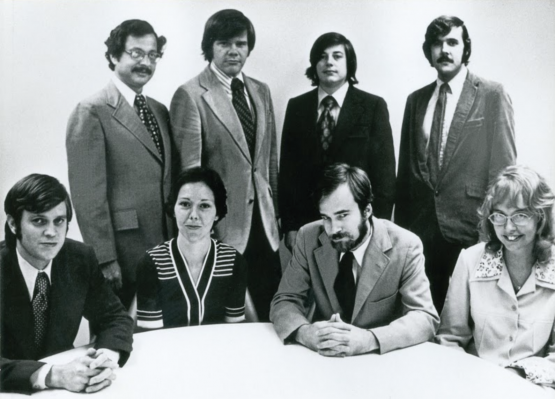
History and Background

Below is a brief timeline that outlines our proud history, spanning more than 100 years. Different milestones, achievements and events have shaped our ever-evolving program. Through the decades, the mission remains the same: equipping journalists with the latest tools and strategies for success.
- 1912: W. M. “Kip” Kiplinger is one of the first two journalism graduates at Ohio State University, where he was editor-in-chief of The Lantern.
- 1913: W. M. Kiplinger covers the Columbus flood as a cub reporter for the Ohio State Journal newspaper.
- 1920: Kiplinger founds a “business intelligence” bureau for banks and other companies.
- 1923: Kiplinger starts The Kiplinger Letter, one of the most widely read business forecasting letters in the world. It remains in production.
- 1947: Kiplinger founds Kiplinger Magazine, today called Kiplinger’s Personal Finance. He is described by The Saturday Evening Post as “the best-paid and most-influential reporter in the world.”
- 1967: W. M. Kiplinger dies.
- 1972: Kiplinger’s son, Austin, longtime editor-in-chief of Kiplinger publishing, creates the Kiplinger Program to memorialize his father’s contributions to journalism.
- 1973: Fellows begin a yearlong master’s degree program at the Ohio State University School of Journalism. Many “kippies” go on to become prize-winning journalists.
- 1979: Keith Miller, Class of 1977, begins a 40-plus-year career as world correspondent for NBC News.
- 1985: Don Benson, Class of 1983, becomes radio news editor at Voice of America.
- 1988: Walt Bogdanich, Class of 1976, wins the Pulitzer Prize for Specialized Reporting at the Wall Street Journal.
- 1995: 1976 Kip Fellow Tony Pederson becomes executive editor of the Houston Chronicle.
- 2001: Christine Spolar, Class of 1983, wins an Emmy for a broadcast she co-produced for 60 Minutes.
- 2003: Diana Sugg, Kiplinger Class of 1992, wins a Pulitzer for her medical reporting for The Baltimore Sun.
- 2004: The program moves to the John Glenn Institute for Public Service and Public Policy, where it becomes a six-month fellowship.
- 2005: Austin Kiplinger is awarded the Fourth Estate Award by the National Press Club.
- 2009: Jerry Mitchell, Class of 1997, is named a MacArthur Fellow for his investigations into the 1960s murders of civil rights leaders including Medgar Evers. His Clarion-Ledger articles led to the conviction of several members of the Ku Klux Klan.
- 2011: Fellowship shifts to an intensive one-week program teaching mid-career journalists to use social media and digital reporting tools. The program moves to University Communications at Ohio State.
- 2012: The Kiplinger Program hosts its first Social Media Summit, teaching journalists social media, deep Web searches, video and personal branding.
- 2012: In a new partnership, the Kiplinger Program begins training at regional Better Watchdog Workshops hosted by Investigative Reporters and Editors.
- 2013: To mark the 40th year of the Kiplinger Program, the Kiplinger family donates an oil painting of W. M. Kiplinger to the university. The portrait is on display at The Lantern newsroom.
- 2014: The Society of Professional Journalists partners with the Kiplinger Program to host “JournCamps” around the country. The first joint JournCamp is held in San Diego.
- 2015: Deputy Director Kevin Z. Smith provides journalism ethics and digital training in Pakistan.
- 2016: Director Doug Haddix is a featured speaker at the Rockit Digital Media conference in Moldova, attended by more than 500 Eastern European journalists and communicators.
- 2017: Kiplinger training explodes. In a few short months, Kiplinger trains more than 350 journalists stateside. Then, acting director Kevin Z. Smith extends Kiplinger's international reach with three separate weeks of overseas training in Zambia, Moldova and Ethiopia. Kiplinger records its largest training session when 140,000 people tune in to a Facebook Live talk about fake news and media literacy in Ethiopia.
- 2018: Kiplinger travels to Moldova and Ethiopia to train journalists and livestreams a workshop before 144,000 people in Addis Abba, Ethiopia.
- 2019: After 46 years at Ohio State University, the program finds a new home at Ohio University’s E.W. Scripps School of Journalism in Athens, Ohio.
- 2022: Kiplinger changes training focus from digital technology to reporting on large scale issues of the time.
- 2023: Kiplinger celebrates its 50th anniversary with a alumni speaker series and a fellowship on media and democracy.
- 2024: Kiplinger Executive Director Kevin Z. Smith is awarded a Fulbright and spends five weeks in The Gambia teaching investigative reporting and media ethics.